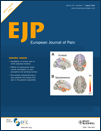The COMT rs4680 Met allele contributes to long-lasting low back pain, sciatica and disability after lumbar disc herniation
Funding sources:
The present work was supported by EXTRA funds from the Norwegian Foundation for Health and Rehabilitation and the Norwegian Research Council.
Conflicts of interest:
The authors state that there are no conflicts of interest.
Abstract
Background
The COMT enzyme metabolizes catecholamines and thus modulates adrenergic, noradrenergic and dopaminergic signaling. A functional polymorphism in the gene encoding this enzyme, i.e. the COMT Val158Met SNP that reduces enzyme activity, has previously been linked to pain sensitivity.
Methods
We examined if the COMT Val158Met SNP could contribute to discogenic subacute low back pain and sciatica by comparing the frequency of the Val158Met genotypes of degenerative disc disease patients with healthy controls. Moreover, we examined if this SNP could predict the clinical outcome, i.e. the progression of pain and disability.
Results
The present data demonstrated that there were no differences in COMT genotype frequencies between the newly diagnosed patients and controls. Analysis of pain and disability in the patients over time revealed, however, a significant or border-line significant increase in McGill sensory score and Oswestry Disability Index (ODI) score for individuals with COMT Met/Met genotype. Furthermore, significant associations between the COMT Met-allele and VAS activity score, McGill sensory score and ODI score were observed in the patients 6 months after inclusion.
Discussion
Although the Val158Met SNP was not a risk factor for disc herniation, patients with Met/Met had more pain and slower recovery than those with Val/Met, which in turn also had more pain and slower recovery than those with Val/Val suggesting the SNP contributes to the progression of the symptoms of disc herniation.
Conclusion
We conclude that the functional COMT Val158Met SNP contributes to long lasting low back pain, sciatica and disability after lumbar disc herniation.




